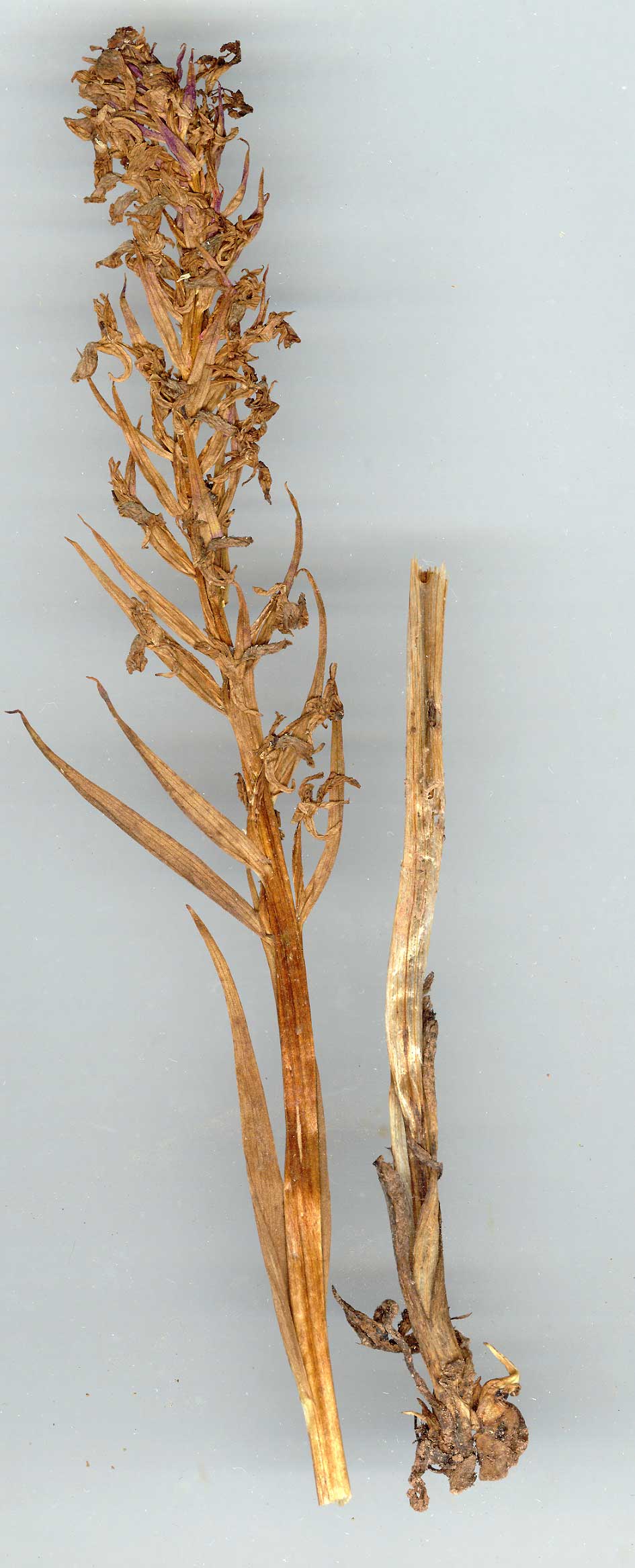| Orchidaceae |
|---|
 BAUMANN ET KUNKELE_jpg.jpg)
Dactylorhiza urvilleana (STEUDEL) BAUMANN ET KUNKELE |
 Dactylorhiza urvilleana (STEUDEL) BAUMANN ET KUNKELE |
Dactylorhiza NECKER EX NEVSKI |
| D. urvilleana (Steudel) Baumann & Künkele in Mitt. Bl. Arbeitskr. Heim. Orch. Baden-Württ. 13:240 (1981). Syn: O. urvilleana Steudel, Nomenclator ed. 2, 2:225 (1841), nom, nov. pro O. saccata d'Urv., Enum. PL Ins. Ponti Eux. 119 (1822) non Ten. (1811); O. triphylla C. Koch in Linnaea 22:283 (1849) nom. illegit. non Sprengel (1826); O. lancibracteata C. Koch, op. cit. 284 (1849) p.p.; O. affinis C. Koch, op. cit. 284(1849); O. basilica Kl. subsp. cartaliniae Kl. in Acta Horti Petrop. 17:196 (1898) p.p.;O. pontica Fleischm. & Hand.-Mazz. in Ann. Nat. Hofmus.Wien 23:208, t.8f.4(1909); O. maculata L. subsp. macrostachys So6 var. cartaliniae Sob in Feddes Rep. 24:32 (1927); O. kncibracteatus C. Koch f. ponticus (Fleischm. & Hand.-Mazz.) Krause in Feddes Rep. 25:88 (1928); Dactylorhiza saccifera (Brongn.) So6 subsp. lancibracteata (So6) So6 var. pontica (Fleischm. & Hand-Mazz.) So6, Nom. Nov. Gen. Dactylorhiza, Budapest 8 (1962); O. amblyoloba Nevski in Fl. URSS 4:753 (1935)! D. maculata (L.) So6 subsp. osmanica (Kl.) Nelson, Monogr. Ikonogr. Dactylorhiza 8 (1976); D. maculata (L.) So6 subsp. triphylla (C. Koch) Sunderm., Europ.Medit. Orchid, ed. 3:40 (1980) nom. illegit.; D. affinis (C. Koch) Aver, in Bot. Zhurn. 68(7):895 (1983). Ic: Nieschalk, op. cit. 105, f. 3(1976). Map 104. Plants usually robust, (15-)20-70 cm. Stem ± hollow (except in slender individuals), with 3-4 well developed leaves. Leaves 15-20 x 3-5 cm, broadly elliptic-obovate to lanceolate, purplish-spotted, sometimes unspotted, upper (l-)2(-3) bract-like. Spike ± dense, to 15(-20) cm long, to 4-6 cm diam. Flowers large, mauve, rose-purple or dark purplish-violet. Sepals and petals lanceolate to ovate-lanceolate, acute to acuminate, to 16 mm. Labellum flat, roundish or tranversely oblong, usually broader than long, (9-)ll-15(-l 7) x 8-10(-12) mm, subentire or ± 3-lobed, densely covered with dots or fine broken lines; middle lobe small, triangular, 4-6 mm; lateral lobes usually large, margins irregularly crenate-dentate or erose. Spur broadly cylindrical, ± obtuse, 11-14 (-17) x 3-5(-6) mm, ± equalling ovary. Fl. 6-7(-8). Moist places in deciduous or coniferous forest, Picea-Rhododendron scrub, nr springs and streams, peaty alpine meadows, s.l-2500 m. Lectotype (designated by Baumann &Künkele,loc. cit., 1981): [Caucasus] Soukoum (Suchumi) in Colchide, vi 1820, J. Dumont d'Urvilie (P, photo!). N. & N.E. Anatolia. A4 Kastamonu: S. of Küre, 1100 m, Renz & Taub. 12276! A5 Sinop: N. slope of Çangal Da., 1100-1200 m, Renz 9087! A6 Sivas: Yildiz Da., Sarıyer, 1700 m, Tobey 2365! Ordu: Tekkiraz to Akkuş, below Duman tepe, 1100 m, Renz & Taub. 12169! A7 Giresun: 3.3 km S. of Kulakkaya towards Yavuzkemal, 1250 m, Sunderm. et al. 76.594! Trabzon: Ziganapass, N.E. side, 1500 m, Man 2049! A8 Çoruh: W. above Artvin, 1300-1600 m,D. 29736! Rize: above Ikizdere, between Çamlik and Sivrikaya, 1700 m,Renz9115! Trabzon: Soganli pass, 1500 m,Furse 3952! A9 Çoruh:Kord-evaıı Da. (Yalnizçam Da.), ar Kütül Y., 2200 m, D. 30215! Kars: Çildir G. (Grossheira 2: map 265, as Orchis amblyoloba). B7 Erzincan: Erzincan to Refahiye, E. of pass, 2000-2500 m, Renz 9301! B8 Erzurum: Palandöken Da., 25 km from Çat to Erzurum, 2350 m, D. 47386! Caucasia. Euxine element. Occurs less frequently S. of the Pontic range (B7 and B8) where it is also less characteristic owing to changed climatic conditions and influences from other taxa such as D. osmanica and D. umbrosa. Baumann & Kûnkele (op. cit. 240-250, 1981) give a detailed discussion of their concept of D. urvilleana, which also includes Koch's Pontic-Caucasian taxa O. triphyila, O. affinis and O. lancibracteata. We prefer to restrict D. lancibracteata to Caspian material (see Renz in Rech. fil., Fl. Iranica 126:135, 1978), distinct from the Pontic plants. Koch's records of O. lancibracteata from Transcaucasia (prov. Erevan) and the Pontic mts. are most likely conspec-ific with D. urvilleana. A better knowledge of the plants occurring in Transcaucasia and the Talysh may possibly lead to the Caspian plants being included in a broader concept of D. urvilleana. |